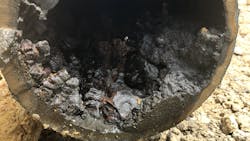Leak detection: a key to ensuring pipeline performance
Discovering and addressing existing leaks in a pipeline is vital for ensuring its long-term performance. Leak detection plays a crucial role in a comprehensive condition assessment program for water utilities. Without proper leak detection, a system can rapidly transition from being stable to entering crisis mode.
One such example of this is the current water crisis facing Jackson, Mississippi, where the aging water distribution system in the city has resulted in an unreliable water supply for both residents and businesses. Visible leaks can be observed along many streets. These unfortunate and distressing circumstances highlight the significance of reliable leak detection tools for water utilities.
In response to the poor status of Jackson's drinking water infrastructure, a court-appointed interim manager of the city's infrastructure created JXN Water LLC to govern the system. A few months ago, JXN Water brought Stantec in to help focus on the distribution system; specifically large diameter leaks, while other contractors were tapped to work on small diameter leaks.
A team was deployed on the ground to stabilize the city’s drinking water distribution system and design improvements for long-term system health while modernizing it for future operations. The project team has engineered and sourced solutions for two identified 48-inch large-diameter waterline breaks, which will prevent the loss of millions of gallons of treated water a day.
Detecting leaks in pipelines
There are several effective devices available that utilize acoustic sensors, which can be inserted into pipelines while they remain in service. The primary objective of these tools is to identify leaks of various sizes and pinpoint their locations. Once a leak is identified, excavation of the pipe is necessary to confirm the precise location and initiate the required repairs. The extent of the repairs necessary are normally not fully known until the pipe is exposed.
The deployment and extraction of this type of leak detection device is relatively straightforward. It can be inserted and extracted through existing connections, allowing for long runs to be performed in a single inspection. Equipped with an acoustic sensor, the tool collects data by listening for leaks and air pockets. It also incorporates an accelerometer and a gyroscope to measure the device’s movements, providing valuable information for pipeline mapping.
During extraction, a specialized net is used to catch the inspection tool and safely remove it from the pressurized and in-service pipeline. This streamlined process minimizes disruptions to regular operations.
In addition to leak detection, it is important to locate air pockets. Identifying high points in the pipeline and ensuring proper venting, along with the functionality of air release valves, is critical — and leak detection tools can do that as well.
By incorporating advanced leak detection tools into pipeline inspection and maintenance programs, operators can proactively identify and address leaks and air pockets. This safeguards the integrity and efficiency of their infrastructure and ensures reliable and comprehensive pipeline condition assessment.
Remote monitoring and satellite-based techniques
In addition to traditional methods, remote monitoring and satellite-based techniques have emerged as valuable tools for proactive leak detection and structural integrity assessment in pipeline systems. Engineering firms recognize the significance of incorporating these innovative approaches to enhance leak detection capabilities.
Remote monitoring systems enable real-time surveillance of pipeline networks, ushering in a new era of proactive leak detection that can be used in places like Jackson in the future. By continuously monitoring key parameters, such as pressure and flow rates, operators can promptly identify anomalies that may indicate leaks or compromised pipeline integrity.
This proactive approach allows for swift response times, minimizing water loss and mitigating potential damage to streets, adjacent utilities and properties. While implementing remote monitoring systems requires an upfront investment in equipment and installation, the long-term benefits far outweigh the initial costs.
Satellite-based leak detection techniques, inspired by the search for water on other planets, offer an exciting advancement in identifying potable water leakage in urban water systems. For example, Stantec’s PipeWATCH is an advanced pipeline leak detection system that utilizes micro-satellite imagery for comprehensive monitoring.
By deploying constellations of small and cost-effective micro-satellites, the system can capture daily imagery of the Earth's entire surface, providing extensive coverage for monitoring changes in vegetation health along pipeline rights-of-way. Through the analysis of visible and near infrared (NIR) energy, the tool generates sensitive vegetation indices that serve as indicators of potential leaks. The system automatically downloads satellite imagery, calculates vegetation health indices, and conducts daily change detection analysis.
This technology excels at identifying increases in vegetation health, thereby flagging potential leak sites. Furthermore, it can detect sub-surface leaks by monitoring changes in surface vegetation. This advanced system is intended to outperform traditional aerial surveys with the use of NIR energy, applying statistical analysis for unbiased results, and creating a comprehensive record of leaks and condition monitoring.
When operators analyze the data satellites capture, they can pinpoint potential leak locations without the need for physical inspections. This approach provides a comprehensive and cost-effective solution for large-scale leak detection.
Incorporating remote monitoring systems and satellite-based leak detection techniques complements traditional methods and enhances the overall effectiveness of leak detection programs. When combining these advanced technologies with industry expertise, operators can achieve reliable and comprehensive pipeline condition assessment.
As the industry continues to evolve, it is crucial to embrace innovative approaches that not only improve leak detection capabilities but also optimize operational efficiency, reduce costs, and minimize environmental impacts. Ideally, as the technologies become more widespread, crises caused by water leaks can be avoided and instead experts can support sustainable and resilient pipeline systems.
